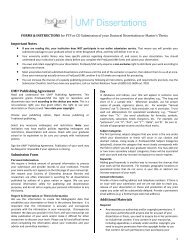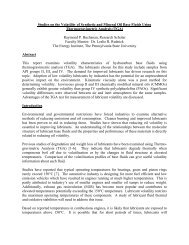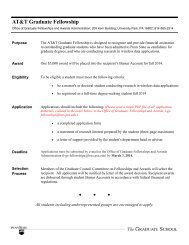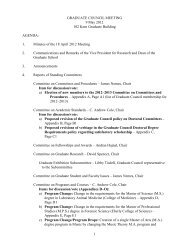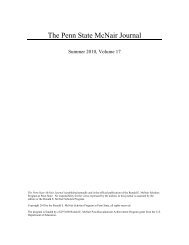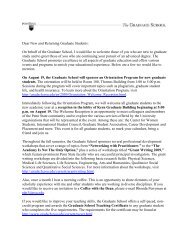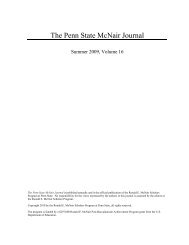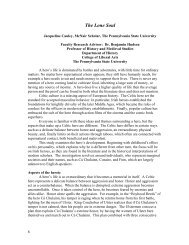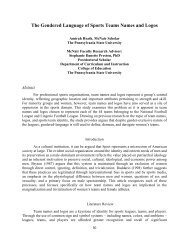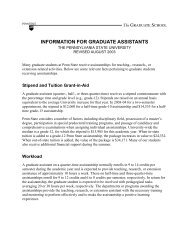resilience in home-based caregivers in limpopo, south africa
resilience in home-based caregivers in limpopo, south africa
resilience in home-based caregivers in limpopo, south africa
You also want an ePaper? Increase the reach of your titles
YUMPU automatically turns print PDFs into web optimized ePapers that Google loves.
I<br />
RESILIENCE IN HOME-BASED CAREGIVERS IN LIMPOPO,<br />
SOUTH AFRICA<br />
Theresa M. Mieh, McNair Scholar<br />
The Pennsylvania State University<br />
McNair Faculty Research Advisor:<br />
Coll<strong>in</strong>s O. Airhihenbuwa, PhD, MPH<br />
Professor and Head, Department of Biobehavioral Health<br />
College of Health and Human Development<br />
The Pennsylvania State University<br />
ABSTRACT<br />
Juliet Iwelunmor<br />
Graduate Assistant, Department of Biobehavioral Health<br />
College of Health and Human Development<br />
The Pennsylvania State University<br />
This study exam<strong>in</strong>es <strong>resilience</strong> <strong>in</strong> <strong>home</strong>-<strong>based</strong> <strong>caregivers</strong> (HBCs) <strong>in</strong> Limpopo South Africa.<br />
The PEN-3 model is used to <strong>in</strong>vestigate cultural <strong>in</strong>fluences on care-giv<strong>in</strong>g and frame the<br />
relationships, expectations, and cultural identity of care-giv<strong>in</strong>g <strong>in</strong> the context of African cultures.<br />
Data were gathered from participants’ responses <strong>in</strong> 4 focus group <strong>in</strong>terviews held <strong>in</strong> South<br />
Africa. The results highlight the positive and supportive aspects of HBCs, recognize the<br />
existential and unique features, and expla<strong>in</strong> the negative experiences shared by HBCs. The<br />
f<strong>in</strong>d<strong>in</strong>gs from this study emphasize the need for persons of African descent to ma<strong>in</strong>ta<strong>in</strong> the<br />
African ideology of ―collectivity‖ <strong>in</strong> care-giv<strong>in</strong>g.<br />
Keywords: HIV/AIDS; <strong>resilience</strong>; <strong>home</strong>-<strong>based</strong> careers; SOUTH AFRICA, PEN-3<br />
INTRODUCTION<br />
Sub-Saharan Africa has the highest number of people liv<strong>in</strong>g with HIV/AIDS (PLWHAs). An<br />
estimated 33.4 million people are liv<strong>in</strong>g with HIV globally (WHO, 2008-2009). Accord<strong>in</strong>g to<br />
WHO (2008-2009), Sub-Saharan Africa cont<strong>in</strong>ues to be the region disproportionally affected by<br />
the HIV/AIDS pandemic account<strong>in</strong>g for 67% of all people liv<strong>in</strong>g with HIV, of which 60% are of<br />
women. Accord<strong>in</strong>g to UNAIDS (2007), <strong>in</strong> South Africa an estimated 18.1% of adults age 15 to<br />
49 are liv<strong>in</strong>g with HIV, while 3,200,000 women age 15 years and older are <strong>in</strong>fected with the HIV<br />
virus. In 2007, approximately 350,000 adults and children died of HIV/AIDS, while an estimated<br />
1,400,000 children lost their mothers, fathers, or both parents to HIV/AIDS (UNAIDS). In<br />
Limpopo Prov<strong>in</strong>ce, approximately 396, 877 people are <strong>in</strong>fected with HIV: 47, 000 new<br />
<strong>in</strong>fections, 39, 474 people already sick, and 24 000 AIDS-related deaths (Dor<strong>in</strong>gton et al. 2006).<br />
Background<br />
The HIV/AIDS pandemic places tremendous pressure on HIV <strong>in</strong>fected households <strong>in</strong> South<br />
Africa. It is predicted that ―HIV is the fastest way for families to move from relative wealth to<br />
188
I<br />
relative poverty‖ (Rotheram-Borus, Flannery, Rice, & Lester, 2005, pg. 981). For example, a<br />
study <strong>in</strong>vestigat<strong>in</strong>g the effect of HIV/AIDS-related mortality on household dependency ratios <strong>in</strong><br />
rural South Africa revealed that household dependency ratio—composite <strong>in</strong>dex that reflects the<br />
comb<strong>in</strong>ed effect of all demographic events and processes <strong>in</strong> the household: births, deaths, age<strong>in</strong>g,<br />
and <strong>in</strong>-migration and out-migration—<strong>in</strong> some parts of South Africa is high, thereby <strong>in</strong>creas<strong>in</strong>g<br />
the effect of los<strong>in</strong>g a productive-age member (Madhavan, S., Schatz, E., & Clark, B., 2009).<br />
HIV/AIDS related mortality can put different stra<strong>in</strong>s on household resources and <strong>in</strong>crease its<br />
care-giv<strong>in</strong>g responsibilities for children and elderly with<strong>in</strong> HIV affected households (Madhavan<br />
et al. 2009). Also, care-giv<strong>in</strong>g can create major time burdens for <strong>caregivers</strong>, exacerbat<strong>in</strong>g poverty<br />
among previously poor <strong>caregivers</strong> (Hansen et al., 1998; L<strong>in</strong>dsey et al., 2003; Ak<strong>in</strong>tola 2004a).<br />
Madhavan et al. (2009) concluded that the age distribution of HIV/AIDS related deaths is<br />
primarily affect<strong>in</strong>g the most productive age group of the African population. Because young<br />
people are more likely to contract and die of HIV/AIDS, the elderly are left with no choice but to<br />
take on care-giv<strong>in</strong>g and breadw<strong>in</strong>n<strong>in</strong>g roles for adult children with symptomatic HIV <strong>in</strong>fection<br />
and orphaned grandchildren made vulnerable by the death or illness of one or both parents (Boon<br />
et al. 2009). In both developed and develop<strong>in</strong>g countries, the death or illness of one or both<br />
parents br<strong>in</strong>gs about the establishment of ―child-head households‖—children assum<strong>in</strong>g adult<br />
roles and responsibilities for other members of the family (Rotheram-Borus, Flannery, Rice, &<br />
Lester, 2005, pg. 982). These roles and responsibilities assumed by children <strong>in</strong> such <strong>in</strong>stances<br />
have been shown to have a significant impact <strong>in</strong> alter<strong>in</strong>g their life course (Rotheram-Borus et al.<br />
2005). As a result, the need for <strong>home</strong>-<strong>based</strong> care becomes even more crucial <strong>in</strong> this regard.<br />
Home-Based Care<br />
Studies exam<strong>in</strong><strong>in</strong>g the impact of care-giv<strong>in</strong>g on family <strong>caregivers</strong> have shown that care-giv<strong>in</strong>g<br />
has a negative impact on the physical and mental health of family <strong>caregivers</strong> (Orner, 2006). In<br />
addition, <strong>caregivers</strong> may also be at elevated risk for contract<strong>in</strong>g <strong>in</strong>fections such as HIV/AIDS<br />
and tuberculosis (L<strong>in</strong>dsey et al., 2003; Ak<strong>in</strong>tola 2006). Studies among family <strong>caregivers</strong> <strong>in</strong><br />
Ghana, Tanzania, South Africa and the Democratic Republic of Congo showed that <strong>caregivers</strong><br />
are also victims of adverse socio-economic consequences, stigma and discrim<strong>in</strong>ation, isolation<br />
and lack of support (Nnko et al. 2000, Mw<strong>in</strong>ituo 2006, Nkosi et al. 2006, Orner 2006). Van Dyk<br />
(2001) stated that <strong>caregivers</strong> are often frustrated by issues associated with their roles— “lack of<br />
basic essentials, <strong>in</strong>accessibility of basic medical care, debilitat<strong>in</strong>g nature of patient’s condition,<br />
lack of knowledge about <strong>in</strong>fection, fear and anxiety associated with stigma and discrim<strong>in</strong>ation,<br />
frustration associated with the premature discharge of the family’s loved one, as well as the<br />
behavior and lifestyle of the sick person, and overwhelmed by the extended roles and lack of<br />
support‖ (pg. 135–143).<br />
Additionally, the HIV/AIDS pandemic places enormous burden on healthcare services <strong>in</strong><br />
Sub-Saharan Africa. In South Africa, PLWHAs constitute the vast majority of patients seek<strong>in</strong>g<br />
medical attention <strong>in</strong> public health facilities (Shisana et al. 2002). Health services are often unable<br />
to provide patients with the care they require; as a result families are faced with the task of car<strong>in</strong>g<br />
for their sick family members at <strong>home</strong> (Ndaba-Mbata & Seloilwe, 2000). Furthermore, the<br />
healthcare system <strong>in</strong> South Africa is experienc<strong>in</strong>g an <strong>in</strong>crease <strong>in</strong> HIV/AIDS <strong>in</strong>fections and deaths<br />
among nurses and other healthcare personnel thereby plac<strong>in</strong>g stra<strong>in</strong>s on public health services<br />
189
I<br />
needed by patients (Aitken & Kemp 2003). Studies conducted <strong>in</strong> Zaire found that the prevalence<br />
of HIV <strong>in</strong>fection among health care professionals <strong>in</strong>creased from 6.4% to 8.6% between 1984<br />
and 1986 (Mann JM, Francis H, Qu<strong>in</strong>n TC, et al., 1986 and N’Galy B, Ryder RW, Bila K, et al.,<br />
1988). Uebel et al. (2007) expla<strong>in</strong>ed how health care workers liv<strong>in</strong>g <strong>in</strong> areas where the<br />
prevalence of HIV <strong>in</strong>fection is high, the disease becomes community acquired, thus the<br />
prevalence of HIV <strong>in</strong>fection among health care workers becomes comparable to that of the<br />
communities <strong>in</strong> which they live. Relatedly, a anonymous survey <strong>in</strong>volv<strong>in</strong>g 595 health care<br />
workers across race groups <strong>in</strong> 4 different prov<strong>in</strong>ces <strong>in</strong> South Africa found an overall HIV<br />
<strong>in</strong>fection prevalence of 15.7%, compared with an estimated prevalence of 15.5% among adults <strong>in</strong><br />
South Africa (Shisana O, Hall EJ, Maluleke R, Chauveau J, Schwabe C., 2004). Aitken and<br />
Kemp (2003) expla<strong>in</strong>ed how poor compensation of healthcare workers and poor work<strong>in</strong>g<br />
conditions of nurses and other healthcare professionals has led to large-scale emigration to<br />
foreign countries of these healthcare workers result<strong>in</strong>g <strong>in</strong> a critical shortage of nurses and other<br />
medical personnel <strong>in</strong> South Africa.<br />
For this and many more reasons, a number of government and non-governmental<br />
agencies have adopted <strong>home</strong>-<strong>based</strong> care as an alternative to hospital care. As a result, PLWHAs<br />
are often sent <strong>home</strong> to be cared for by their family members. Institutionally, <strong>home</strong> care programs<br />
for people with AIDS (PWAs) started <strong>in</strong> North America and Europe as an alternative to help<br />
m<strong>in</strong>imize hospital expenses, and to assist families and other <strong>caregivers</strong> cope with the challenges<br />
of car<strong>in</strong>g for PWAs (Spier & and Edward 1990). However, the act of selfless care-giv<strong>in</strong>g has<br />
been a part of Africa culture. This practice provides the value for Africans to see themselves as<br />
part of the historically large community (collective) to which they belong (Mbiti, 1969: 108-<br />
109). Consider<strong>in</strong>g the difficulties associated with provid<strong>in</strong>g <strong>home</strong>-<strong>based</strong> care <strong>in</strong> Africa, due to<br />
the crowded and substandard conditions <strong>in</strong> which most PWAs live, Spier & Edwards (1990)<br />
concluded that, what PWAs need most is ―counsel<strong>in</strong>g, lots of personal contact and empathy and<br />
a sense of belong<strong>in</strong>g‖ (p. 144). Nevertheless, <strong>in</strong> Norway the emphasis of <strong>home</strong>-<strong>based</strong> AIDS care<br />
is focused on domestic tasks such as clean<strong>in</strong>g, laundry and shopp<strong>in</strong>g (Bunch, 1998); while <strong>in</strong> the<br />
USA <strong>home</strong>-<strong>based</strong> AIDS care is centered on problems <strong>in</strong> <strong>home</strong> ma<strong>in</strong>tenance, <strong>in</strong>dividual cop<strong>in</strong>g,<br />
nutrition, feed<strong>in</strong>g and fatigue (Ungvarski & Hurley, 1995) . Home-<strong>based</strong> care PWAs was<br />
<strong>in</strong>troduced <strong>in</strong> a number of African countries dur<strong>in</strong>g the late 1980s and early 1990s (Sims &<br />
Moss, 1995). In South Africa, <strong>home</strong>-<strong>based</strong> <strong>caregivers</strong> advise, <strong>in</strong>form and counsel patients (L R<br />
Uys, 2002) with the supervision of registered nurses. Accord<strong>in</strong>g to Ste<strong>in</strong>berg et al. (2002),<br />
volunteers make-up a substantial proportion of HIV/AIDS <strong>caregivers</strong> <strong>in</strong> South Africa. Volunteer<br />
<strong>caregivers</strong> are usually not members of the patient’s family but often people recruited from HIV<br />
<strong>in</strong>fected communities by AIDS organizations (Ak<strong>in</strong>tola, 2008). They are tra<strong>in</strong>ed to assist family<br />
members <strong>in</strong> provid<strong>in</strong>g care for the PLWHAs (Bl<strong>in</strong>khoff et al. 2001, Ste<strong>in</strong>itz 2003, Ak<strong>in</strong>tola<br />
2006) and to work hand <strong>in</strong> hand with cl<strong>in</strong>ics and hospitals (Campbell, C; Nair, Y; Maimane, S;<br />
Sibiya, Z; 2008). Few volunteer health workers have basic education and they worked with little<br />
or no payment to cover their expenses (Campbell, C; Nair, Y; Maimane, S; Sibiya, Z; 2008). For<br />
example, at the time the present study was conducted <strong>in</strong> 2005, participants received a stipend of<br />
R500-00 ($64.5970) from the **South African** government to cover HBCs daily transportation<br />
and to enable them purchase food and dr<strong>in</strong>ks. However, the provision of this stipend soon came<br />
to an end when the program ended <strong>in</strong> 2006 and 2007. Even though much has been written on<br />
<strong>caregivers</strong>—challenges: physical, psychological, and cop<strong>in</strong>g mechanisms— much has not been<br />
190
I<br />
studied regard<strong>in</strong>g <strong>resilience</strong> <strong>in</strong> <strong>home</strong>-<strong>based</strong> <strong>caregivers</strong> <strong>in</strong> Limpopo South Africa. The PEN-3<br />
model is used to exam<strong>in</strong>e cultural <strong>in</strong>fluences on care-giv<strong>in</strong>g and frame the relationships,<br />
expectations, and cultural identity of care-giv<strong>in</strong>g <strong>in</strong> the context of African cultures.<br />
The Concept of Resilience<br />
The concept of <strong>resilience</strong> is derived from the discipl<strong>in</strong>es of physics and metallurgy (John Paul<br />
Lederach, pg. 24). Resilience, <strong>in</strong> this context, is applied to a special family of metal that when<br />
placed under <strong>in</strong>tense heat will lose shape, soften and meld, however when re-cooled has an<br />
<strong>in</strong>credible ability to return to its <strong>in</strong>itial shape (John Paul Lederach, pg. 23). Nonetheless, <strong>in</strong><br />
developmental psychology and social work <strong>resilience</strong> is exam<strong>in</strong>ed <strong>in</strong> children who have<br />
withstand and rebound from vulnerable and high-risk situations, thus f<strong>in</strong>d<strong>in</strong>g their way toward<br />
expressively healthy childhoods and responsible adulthoods (Walsh, 1996, John Paul Lederach,<br />
pg. 24).<br />
Contrary to the typical <strong>in</strong>terpretation of <strong>resilience</strong>, this article advances a culturally<br />
sensitive view of this concept, thus def<strong>in</strong><strong>in</strong>g <strong>resilience</strong> as the ―sensation of be<strong>in</strong>g voiceless‖<br />
(John Paul Lederach, pg. 24). John Paul Lederach expla<strong>in</strong>ed how the process from be<strong>in</strong>g<br />
voiceless to acquir<strong>in</strong>g a voice requires the need for people to feel close enough to procedures that<br />
affect their daily personal and collective lives, so that a sense of mean<strong>in</strong>gful conversation is<br />
actually possible. In the Western world, <strong>resilience</strong> has been viewed as resid<strong>in</strong>g with<strong>in</strong> the<br />
<strong>in</strong>dividual, with the family often dismissed as dysfunctional (Walsh, 1996). However, <strong>in</strong> African<br />
cultures, the <strong>in</strong>volvement and support of the collective— government and non-governmental<br />
agencies, families of PLWHAs, and community members—<strong>in</strong> assist<strong>in</strong>g HBCs acquire a voice to<br />
adequately provide care to PLWHAs is highly urged.<br />
THEORETICAL FRAMEWORK<br />
The PEN-3 model developed by Airhihenbuwa (1995, Airhihenbuwa & Webster, 2004; 2007a) is<br />
used as the conceptual framework on which this study will be organized. This model proposes a<br />
strategy for organiz<strong>in</strong>g and analyz<strong>in</strong>g cultural <strong>in</strong>fluences on health behaviors and plann<strong>in</strong>g<br />
culturally appropriate health education programs (Iwelunmor et al. 2006/2007). Also, PEN-3<br />
provides a cultural framework for researchers and <strong>in</strong>terventionist by urg<strong>in</strong>g them <strong>in</strong>to partner<strong>in</strong>g<br />
with communities when def<strong>in</strong><strong>in</strong>g health problems and seek<strong>in</strong>g solutions to those problems<br />
(Airhihenbuwa, 2007a). Hav<strong>in</strong>g been developed <strong>in</strong>itially as a basis for comprehend<strong>in</strong>g health<br />
behaviors of persons of African descent (Airhihenbuwa & Webster, 2004), the PEN-3 model is<br />
used <strong>in</strong> the identification of positive, unique, and negative aspects of African cultures.<br />
PEN-3 consists of three dimensions: cultural empowerment, relationships and<br />
expectations, and cultural identity (Airhihenbuwa, 2007a). The Relationships and Expectations<br />
and Cultural Empowerment doma<strong>in</strong>s are the ―assessment‖ dimensions, which enable<br />
researchers/<strong>in</strong>terventionists evaluate communities of <strong>in</strong>terest before plann<strong>in</strong>g <strong>in</strong>terventions. The<br />
first dimension of the assessment doma<strong>in</strong> is relationships and expectations (perceptions,<br />
enablers, and nurturers). We exam<strong>in</strong>ed how HBCs perceptions of HIV and AIDS helped enabled<br />
and nurtured PLWHA. The second dimension of this evaluation framework is cultural<br />
empowerment (positive, existential, and negative). We exam<strong>in</strong>ed the extent to which the three<br />
levels of relationships and expectations are positive and supportive of PLWHA, existential <strong>in</strong><br />
191
I<br />
that it is ma<strong>in</strong>ta<strong>in</strong><strong>in</strong>g African values, and negative <strong>in</strong> mak<strong>in</strong>g HBCs voiceless due to the lack of<br />
support. Accord<strong>in</strong>g to Airhihenbuwa (2007a), existential values—cultural beliefs and practices,<br />
and/or behaviors that make the culture unique, which has no harmful health consequences—<br />
should not be targeted for change, but rather <strong>in</strong>tegrated to help improve <strong>in</strong>terventions undertaken<br />
<strong>in</strong> such communities.<br />
Cultural identity (person, extended family, and neighborhood) is the third dimension of<br />
the PEN-3 model. This dimension is the ―application‖ doma<strong>in</strong>, which emphasizes the need for<br />
researchers/<strong>in</strong>terventionists to return to the communities from which their f<strong>in</strong>d<strong>in</strong>gs were<br />
acquired, to share their f<strong>in</strong>d<strong>in</strong>gs, and to further learn from these communities before decid<strong>in</strong>g<br />
where to beg<strong>in</strong> their <strong>in</strong>terventions: po<strong>in</strong>t of entry (Airhihenbuwa, 2007a).<br />
METHOD<br />
Data gathered from the study ―Stigma, Cuture, and HIV and AIDS <strong>in</strong> the Western Cape, South<br />
Africa: An Application of PEN-3 Cultural Model for Community-Based Research‖<br />
(Airhihenbuwa et al. 2009), is used <strong>in</strong> this study. The aforementioned study was a capacity<br />
build<strong>in</strong>g HIV and AIDS stigma research <strong>in</strong> South Africa for Black post-graduate students <strong>in</strong> the<br />
University of Western Cape and the University of Limpopo. Focus group discussions were<br />
conducted among <strong>home</strong>-<strong>based</strong> <strong>caregivers</strong> over a period of **one to two** years <strong>in</strong> three different<br />
communities <strong>in</strong> South Africa—Khayelitsha and Gugulethu, and Mitchell’s Pla<strong>in</strong>. Participants<br />
were made known of the study’s content and proceed<strong>in</strong>gs <strong>in</strong> their native languages by the focus<br />
group facilitators; <strong>in</strong>formed consents were solicited from each participant.<br />
Sample<br />
A total of 4 focus groups (FGs) <strong>in</strong>terviews were conducted among 41participants. The<br />
numbers of participants differed <strong>in</strong> each FGs. For example, FGs one, two, three, and four<br />
comprised of n<strong>in</strong>e, eleven, ten, and eleven participants respectively. HBCs were <strong>in</strong>terviewed to<br />
provide a better understand<strong>in</strong>g on how they perceived their work—positive, existential, and<br />
negative perceptions.<br />
Data Collection<br />
Dur<strong>in</strong>g the <strong>in</strong>terviews, probes were used by focus group facilitators only when<br />
permission was <strong>in</strong>quired and granted by participants. Focus group <strong>in</strong>terviews were facilitated by<br />
post-graduate students and they followed an open-ended questions format. Data were collected<br />
us<strong>in</strong>g languages preferred by the participants—either isi-Xhosa, English, or Afrikaans. The<br />
focus group <strong>in</strong>terview guide for this portion of the above mentioned study comprised of **18-<br />
28** questions or scenarios for the duration of **30-60 m<strong>in</strong>utes**.<br />
Data Analysis<br />
Us<strong>in</strong>g NVivo software package for data analysis, four <strong>home</strong>-<strong>based</strong> <strong>caregivers</strong> transcripts<br />
were coded us<strong>in</strong>g two forms of notes—free notes and trees notes. Free notes cod<strong>in</strong>g is the first<br />
stage of data analysis with NVivo and it <strong>in</strong>volves cod<strong>in</strong>g participants’ transcripts verbatim. Also,<br />
192
I<br />
free notes cod<strong>in</strong>g requires no form of organization or group<strong>in</strong>g of ma<strong>in</strong> themes. However, <strong>in</strong> tree<br />
notes cod<strong>in</strong>g, ma<strong>in</strong> codes generated by free notes are condensed <strong>in</strong>to manageable categories to<br />
enhance a better understand<strong>in</strong>g of the results produced. After all transcripts were coded, the<br />
number of free notes codes generated differed between transcripts. For example, transcripts one,<br />
two, three, and four produced 135, 163, 182, and 167 free notes respectively. However, there<br />
were five predom<strong>in</strong>ant themes (tree notes) generated: HBCs, community members, HIV/AIDS¸<br />
family members of PLWHA, and government and non-governmental agencies.<br />
RESULTS<br />
The follow<strong>in</strong>g three ma<strong>in</strong> themes emerged from the analysis of the focus group <strong>in</strong>terviews:<br />
HBCs as sources of hope and support (positive perceptions, positive enablers, and positive<br />
nurturers); HBCs assum<strong>in</strong>g the role of family (existential perception, existential enablers, and<br />
existential nurturers); voicelessness of HBCs due to the lack of support (negative perception,<br />
negative enablers, and negative nurturers). As recommended by Airhihenbuwa, when<br />
implement<strong>in</strong>g PEN-3, researchers and <strong>in</strong>terventionist must first present the positive and the<br />
existential aspects of the communities be<strong>in</strong>g studied, before stat<strong>in</strong>g the negatives. The<br />
aforementioned themes are illustrated with quotes from the participants. Quotes were organized<br />
<strong>in</strong>to one of the n<strong>in</strong>e possible categories of the PEN-3 analysis framework. Even though quotes<br />
were organized <strong>in</strong> the general study, <strong>in</strong> this paper, the results were organized <strong>in</strong>to positive,<br />
existential, and negative aspects of the Cultural Empowerment doma<strong>in</strong> of the PEN-3 model.<br />
HBCs as Sources of Hope and Support (Positive)<br />
Focus group discussions and <strong>in</strong>-depth <strong>in</strong>terviews revealed that HBCs were accept<strong>in</strong>g of<br />
and will<strong>in</strong>g to provide care for PLWHAs and their families. This f<strong>in</strong>d<strong>in</strong>g is consistent with that<br />
of previous studies which highlighted how most HBCs expressed satisfaction <strong>in</strong> their work and<br />
<strong>in</strong> help<strong>in</strong>g others (L R Uys, 2002). The follow<strong>in</strong>g quotation illustrates this further,<br />
I don’t see a problem with my scope of work <strong>in</strong> relation to HIV/AIDS. I only see a person who is sick, alike<br />
me that need to be given medication to prolong his/her life. I don’t have to be confused that I will get an<br />
illness. I don’t have to judge, but to admit.<br />
In addition, HBCs counseled and provided <strong>in</strong>formation to PLWHAs, hence enabl<strong>in</strong>g<br />
patients cope better with their positive HIV status. This may be <strong>in</strong>dicative of the knowledge<br />
HBCs acquired through tra<strong>in</strong><strong>in</strong>g and from their daily <strong>in</strong>teractions with patients. One participant<br />
remarked, ―I would like to <strong>in</strong>dicate that we have a better understand<strong>in</strong>g because we treat the<br />
people and we are able to see them‖. Another participant expressed,<br />
My client was <strong>in</strong> Grade 11, and recently discovered that he was HIV/AIDS positive, so he thought the was<br />
no future to live for, so he decided to take the suicide route, until I counseled him, he then adjusted quite<br />
well.<br />
Furthermore, the participants <strong>in</strong> this study assumed some of the responsibilities of<br />
healthcare workers <strong>in</strong> South Africa, thus allow<strong>in</strong>g the understaffed and underfunded public<br />
healthcare systems to adequately provide care for PLWHAs (Rödlach, 2009). As evidenced <strong>in</strong><br />
the responses of many participants, HBCs assisted <strong>in</strong> the provision of basic physical care<br />
193
I<br />
rendered to PLWHAs <strong>in</strong> South Africa. One participant expla<strong>in</strong>ed, ―They are grateful, because we<br />
don’t disguise them; we help them with a smile on our faces, even when we are remov<strong>in</strong>g those<br />
waste products. We ma<strong>in</strong>ta<strong>in</strong> some collaboration‖. As another participant expressed it,<br />
It is not the same, for a person who has full blown AIDS, he/she might be bedridden and unable to do<br />
anyth<strong>in</strong>g for himself/herself and the patient will first require you to bath him and take him to the toilet, but<br />
with other patient they can still do th<strong>in</strong>g for themselves.<br />
HBCs assum<strong>in</strong>g the role of Family (Existential)<br />
Participants expressed dedication and determ<strong>in</strong>ation to support PLWHAs and their<br />
families (Rödlach, 2009). This f<strong>in</strong>d<strong>in</strong>g re<strong>in</strong>forced the f<strong>in</strong>d<strong>in</strong>gs of Mbiti, Menkiti, Asante, Akbar,<br />
Karenga, Myer, and Graham which urges the need for collectivity rather than personhood <strong>in</strong><br />
African cultures. The notion of collectivity demands the responsibility of the whole, hence what<br />
happens to the <strong>in</strong>dividual happens to the collective, and what happens to the whole group<br />
happens to the <strong>in</strong>dividual (Mbiti, 1970, p.141). For this reason, it wasn’t uncommon for HBCs<br />
to assume the role of families even when illness was not the responsibility of family members.<br />
The follow<strong>in</strong>g quotations highlight this further:<br />
You will f<strong>in</strong>d that someone is hav<strong>in</strong>g a client that is sick, and need to taken to a cl<strong>in</strong>ic, and/or a certa<strong>in</strong><br />
referral be made, you will have to devote yourself.<br />
The client may refuse to go to a cl<strong>in</strong>ic/doctor if <strong>in</strong>formed by the family members, but if it is me the <strong>home</strong><br />
<strong>based</strong> carer I will work with him/her until I w<strong>in</strong> the trust of the patient.<br />
The participants mentioned the deaths of community members due to HIV/AIDS as a<br />
motivational factor for which they provided care to PLWHAs and their families. As remarked by<br />
several participants, ―It is because people are dy<strong>in</strong>g as a result of this disease, which is why we<br />
devote ourselves‖. As evidenced <strong>in</strong> the responses of most participants, the act of selfless caregiv<strong>in</strong>g<br />
is existential (unique) to African cultures, which encourage persons of African descent to<br />
view themselves and their roles <strong>in</strong> the society as belong<strong>in</strong>g to the community at large (Mbiti,<br />
1969: 108-109). This collective nature of identity is further expressed <strong>in</strong> the African proverb ―I<br />
am because we are and because we are therefore I am‖ (Mbiti, 1970, p. 1410).<br />
Moreover, care-giv<strong>in</strong>g enabled HBCs develop a sense of belong<strong>in</strong>g and k<strong>in</strong>ship with<br />
other members of the society (Mahilall, 2006) <strong>in</strong> which they worked and resided. These<br />
relationships allowed HBCs acquire a sense of purpose and connection with families and<br />
community (Akbar, 1976), thus the notion that <strong>in</strong>dividuals cannot be understood separately from<br />
the collective (Myers, 1988). This f<strong>in</strong>d<strong>in</strong>g is clearly exemplified <strong>in</strong> the words of one participant,<br />
―It is the work that I have vowed to do, I said to, myself I will work for the community‖.<br />
Another participant expressed, ―We only understand that there is no cure, but the only best th<strong>in</strong>g<br />
that we can do, is to help this people that are <strong>in</strong>fected and affected with HIV/AIDS‖.<br />
The participants repeatedly described care-giv<strong>in</strong>g as a selfless act of provid<strong>in</strong>g care to<br />
PLWHAs, <strong>in</strong> spite the risk of contract<strong>in</strong>g the HIV/AIDS virus. One participant remarked, ―We<br />
are not protected. We are risk<strong>in</strong>g with our own lives for car<strong>in</strong>g for these people who are<br />
bedridden. You just care‖. This may be <strong>in</strong>dicative of the concept of oneness which requires a<br />
194
I<br />
shift <strong>in</strong> th<strong>in</strong>k<strong>in</strong>g toward valu<strong>in</strong>g human be<strong>in</strong>gs above the social and economic status that has<br />
been assigned to them (Graham, 1999). Also, <strong>in</strong>-depth discussions and focus group <strong>in</strong>terviews<br />
revealed that HBCs will<strong>in</strong>gly rendered care to PLWHAs. As expressed by one participant, ―It’s<br />
because we choose to work out of love‖. Another participant said, ―It is com<strong>in</strong>g out of passion‖.<br />
The participants often mentioned feel<strong>in</strong>gs of confidence <strong>in</strong> themselves and their work as a<br />
result of the useful knowledge they had ga<strong>in</strong>ed on HIV and AIDS (Mahilall, 2006). One<br />
participant remarked, ―I just feel proud and it is also volunteer<strong>in</strong>g and it’s platform for me to<br />
learn‖. Furthermore, participants felt that the tra<strong>in</strong><strong>in</strong>g they received enabled them educate their<br />
community members to take precautionary measures to protect themselves (Ak<strong>in</strong>tola, 2008) from<br />
contract<strong>in</strong>g the HIV virus. One participant expressed, ―It is difficult to work with this people, but<br />
given the love we are committed to care and educate these people‖. This f<strong>in</strong>d<strong>in</strong>g highlights the<br />
need for people of African descent to fulfill their duties to the collective (Menkiti, 1984).<br />
Voicelessness of HBCs due to lack of support (Negative)<br />
In spite of the will<strong>in</strong>gness of HBCs to provide care to PLWHAs, <strong>home</strong>-<strong>based</strong> care<br />
programs receive very limited support from the government (Ste<strong>in</strong>berg et al. 2002) and also<br />
from donor agencies to fund <strong>caregivers</strong> salaries (Ak<strong>in</strong>tola, 2004b), thereby leav<strong>in</strong>g care<br />
organizations with little option but to rely primarily on volunteers to provide care (UNAIDS<br />
2000; Ak<strong>in</strong>tola 2004b). With the absence of support and the lack of recognition displaced by the<br />
government, HBCs <strong>in</strong> South Africa are f<strong>in</strong>d<strong>in</strong>g it very difficult to carry out their daily duties.<br />
Recent data showed that <strong>home</strong>-<strong>based</strong> care organizations <strong>in</strong> South Africa are <strong>in</strong> need of assistance<br />
from government and non-governmental agencies (NGO) <strong>in</strong> order for HBCs to be able to provide<br />
care efficiently. The follow<strong>in</strong>g quotations exemplify this further:<br />
Phutanang itself as Home <strong>based</strong> care is lack<strong>in</strong>g funds, so far we asked for donations from the DoPW. Our<br />
budget is low that it does not allow us to have a proper accommodation.<br />
I plead with other companies that have a social responsibility to help <strong>in</strong> provid<strong>in</strong>g us with the necessary<br />
needs even companies abroad.<br />
Because care organizations <strong>in</strong> South Africa receive little or no f<strong>in</strong>ancial support from<br />
government and non-governmental agencies (Ak<strong>in</strong>tola, 2004b), HBCs are lack<strong>in</strong>g the necessary<br />
skills and capacity build<strong>in</strong>g preparations required to effectively assist with the enormous needs<br />
they encounter <strong>in</strong> their work (Rödlach, 2009). The follow<strong>in</strong>g participant’s description is<br />
illustrative:<br />
I want to refer to the statement of N0. 3, that we received different tra<strong>in</strong><strong>in</strong>g and we are still lack<strong>in</strong>g <strong>in</strong><br />
tra<strong>in</strong><strong>in</strong>g and we are us<strong>in</strong>g our knowledge to counsel.<br />
The lack of tra<strong>in</strong><strong>in</strong>g, I am not sure if carers will answer that openly, the gloves are the only th<strong>in</strong>g that we<br />
use, we don’t know how to handle the patient, when the patient is present<strong>in</strong>g m<strong>in</strong>or complications of<br />
his/her.<br />
Although the participants <strong>in</strong> this study did not expect anyth<strong>in</strong>g <strong>in</strong> return, they expressed a<br />
desire for some recognition (Rödlach, 2009) for their work. HBCs felt that the work they were<br />
do<strong>in</strong>g was similar to a full-time job but was not regarded as such (Rödlach, 2009). Also, HBCs<br />
195
I<br />
expressed feel<strong>in</strong>gs of frustration and disappo<strong>in</strong>tment due to the lack of support and the absence<br />
of recognition displaced by the government regard<strong>in</strong>g their work. The follow<strong>in</strong>g quotations<br />
expla<strong>in</strong> this further:<br />
The government should <strong>in</strong>crease the payment of Home-<strong>based</strong> carers because the work that they are do<strong>in</strong>g is<br />
difficult and the government should register the <strong>home</strong>-<strong>based</strong> carers.<br />
I would like the government to acknowledge that we are overworked, and we don’t have anyone to take<br />
care of us as we do a lot of work.<br />
Additionally, HBCs encountered various challenges from the families of PLWHAs. This<br />
may be <strong>in</strong>dicative of the fact that the families of PLWHAs are afraid of been stigmatized and<br />
discrim<strong>in</strong>ated aga<strong>in</strong>st by their friends and relatives with<strong>in</strong> the communities <strong>in</strong> which they resided.<br />
Furthermore, studies have revealed that stigmatization of the families of PLWHAs is a harmful<br />
and damag<strong>in</strong>g issue (Campbell et al. 2005) that can tremendously impact the reputation of the<br />
families to whom PLWHAs belong. This f<strong>in</strong>d<strong>in</strong>g showed that community members have not yet<br />
come to the realization that HIV/AIDS exist. The follow<strong>in</strong>g quotations expla<strong>in</strong> this further:<br />
Many people have not agreed that HIV/AIDS exist, they do not agree with us, because we the Home Based<br />
Carers have realized that HIV/AIDS do exist. We observed people that we treat, to evidence that<br />
HIV/AIDS is not someth<strong>in</strong>g that is a figure of speech, it exists.<br />
Is just that people don’t believe that HIV/AIDS exist because there is no grave that is impr<strong>in</strong>ted on it as the<br />
grave of a person who died from HIV/AIDS.<br />
In addition, the participants mentioned that family <strong>caregivers</strong> feared to touch and make<br />
close contact with their AIDS relatives (Rödlach, 2009), thereby <strong>in</strong>creas<strong>in</strong>g HBCs daily caregiv<strong>in</strong>g<br />
responsibilities. Moreover, research have shown that people liv<strong>in</strong>g with AIDS experience<br />
cont<strong>in</strong>uous hardships due to blames directed at them for their conditions, and misconceptions<br />
regard<strong>in</strong>g causal social contact with them (Herek, Capitanio, & Widaman, 2002). Also, because<br />
the HIV <strong>in</strong>fection carries the stigma of immorality, promiscuity and prostitution <strong>in</strong> Africa, stigma<br />
associated with the disease and its related shame has <strong>in</strong>creased (Rödlach, 2009). This f<strong>in</strong>d<strong>in</strong>g is<br />
clearly expressed <strong>in</strong> the follow<strong>in</strong>g quotes:<br />
The family members of the HIV/AIDs <strong>in</strong>fected person can hide the sick person until he/she dies. They may<br />
th<strong>in</strong>k that it is ―Makgoma‖ or they are bewitched.<br />
Some of the family member oust the patient, if you are the carer every time you come for the patient they<br />
just refer you to the patient, this implies that the family members have thrown <strong>in</strong> the towel, leav<strong>in</strong>g the<br />
patient all to the <strong>home</strong> <strong>based</strong> carers.<br />
Participants stated that their patients trusted and thus shared confidential <strong>in</strong>formation with<br />
them. Even though HBCs did not encounter difficulties keep<strong>in</strong>g the confidential <strong>in</strong>formation of<br />
their HIV positive patients, they found it rather challeng<strong>in</strong>g ma<strong>in</strong>ta<strong>in</strong><strong>in</strong>g the privacy of their<br />
client’s conditions (Ak<strong>in</strong>tola, 2008) particularly from other members of the patient’s family who<br />
resided with<strong>in</strong> the same households. One participant expla<strong>in</strong>ed,<br />
The other challenge that we encounter is that you are the one that will know the patient, the family<br />
members knows that he/she is a patient but they don’t even know his/her room. They will know that they<br />
have a patient. Aga<strong>in</strong> they will know that they have a patient, but they will turn to you as the carer to ask<br />
196
I<br />
about the condition of the patient and as a carer you have to ma<strong>in</strong>ta<strong>in</strong> the issue of confidentially, if the<br />
patient have not disclosed to them you also have no right to tell them.<br />
Participants expla<strong>in</strong>ed how PLWHAs refra<strong>in</strong>ed from disclos<strong>in</strong>g their positive HIV status<br />
for fear of stigmatization and discrim<strong>in</strong>ation, thus isolat<strong>in</strong>g themselves from sources of support<br />
(Nnko et al. 2000, Ak<strong>in</strong>tola 2004a, 2006). Furthermore, studies have <strong>in</strong>dicated that<br />
stigmatization and discrim<strong>in</strong>ation aga<strong>in</strong>st PLWHAs are primary barriers to effective HIV<br />
prevention, treatment, care, and support (Shisana et al., 2005) aimed at <strong>in</strong>creas<strong>in</strong>g HIV/AIDS<br />
awareness and decreas<strong>in</strong>g its spread. As one participant stated, ―We f<strong>in</strong>d it as a challenge<br />
because people have not yet accepted their status, they don’t want to disclose their status to the<br />
carers, and they don’t want to take treatment‖. Another remarked, ―To concur with No.4, they<br />
are afraid to make contact with the community because they are rejected. When you as the carer<br />
you visit the patient for treatment they are afraid to see‖.<br />
In spite of HBCs selfless act to provide care for PLWHAs, participants expressed feel<strong>in</strong>g<br />
less competent to adequately alleviate the pa<strong>in</strong> and suffer<strong>in</strong>g of their patients (Ak<strong>in</strong>tola, 2008).<br />
Also, HBCs constant exposure to the suffer<strong>in</strong>g and the loss of term<strong>in</strong>ally ill patients (Defilippi,<br />
2003b) had a psychological and emotional impact <strong>in</strong> their lives. One participant stated, ―It<br />
affects me to an extent that I feel guilty, because some of my patients die and leave small<br />
children to have no one to care for them and it br<strong>in</strong>g about child-headed households‖. Another<br />
participant remarked,<br />
It affect me, more or less the same as the previous speaker. We <strong>in</strong>teract with the patient; at times you meet<br />
a patient while he/she is at an HIV stage. You can see the problem that the patient is go<strong>in</strong>g through as well<br />
as his family problems. When you are on your own you imag<strong>in</strong>e about the family situation of the patient,<br />
while on the other side the demands of the family are wait<strong>in</strong>g for you. As the carer you will just wish like<br />
you can f<strong>in</strong>d a vacc<strong>in</strong>e that you can give the patient to make him feel better.<br />
Patients overload was a major problem encountered by the participants <strong>in</strong> this study.<br />
HBCs often mentioned feel<strong>in</strong>gs of exhaustion and burnout as a result of their case loads. This<br />
may be <strong>in</strong>dicative of the <strong>in</strong>creas<strong>in</strong>g number of AIDS patients <strong>in</strong> South Africa, thus HBCs have<br />
become responsible for visit<strong>in</strong>g (Rödlach, 2009) and provid<strong>in</strong>g care to many households <strong>in</strong><br />
which PLWHAs resides. One participant said,<br />
When I am look<strong>in</strong>g on our workload, I will be talk<strong>in</strong>g from the organization frame of reference. The work<br />
that we do require us to see 7 patients, and all of them come with challenges. There is no s<strong>in</strong>gle day that<br />
goes by without any problems. The work is too heavy; there is no carer that has only 2 patients. Even I the<br />
coord<strong>in</strong>ator it takes me 2 to 3 days before I f<strong>in</strong>ish the work I am supposed to be do<strong>in</strong>g.<br />
DISCUSSION<br />
It is evident that the HIV/AIDS pandemic is wreak<strong>in</strong>g havoc on Sub-Saharan Africa. However,<br />
studies have shown that South Africa has the highest number of PLWHAs <strong>in</strong> Sub-Saharan<br />
Africa. Furthermore, numerous studies have concluded that the HIV/AIDS pandemic places<br />
tremendous stra<strong>in</strong>s on: HIV <strong>in</strong>fected households, family <strong>caregivers</strong> of PLWHAs, healthcare<br />
services, and <strong>home</strong>-<strong>based</strong> <strong>caregivers</strong> <strong>in</strong> South Africa. For these and many more reasons, this<br />
article exam<strong>in</strong>ed <strong>resilience</strong> <strong>in</strong> Home-Based Caregivers <strong>in</strong> Limpopo South Africa.<br />
197
I<br />
The f<strong>in</strong>d<strong>in</strong>gs from this study expla<strong>in</strong>ed how the African ideology of ―collectivity‖ is<br />
central <strong>in</strong> assist<strong>in</strong>g HBCs acquire a voice <strong>in</strong> South Africa. The concept of <strong>resilience</strong> def<strong>in</strong>ed as<br />
the ―sensation of be<strong>in</strong>g voiceless‖ was important <strong>in</strong> shap<strong>in</strong>g HBCs positive, existential, and<br />
negative perceptions regard<strong>in</strong>g care-giv<strong>in</strong>g <strong>in</strong> the follow<strong>in</strong>g ways. First, most of the 41<br />
participants expressed satisfaction <strong>in</strong> their work and <strong>in</strong> help<strong>in</strong>g others, this may be <strong>in</strong>dicative of<br />
HBCs tra<strong>in</strong><strong>in</strong>g, daily <strong>in</strong>teractions with patients, and understand<strong>in</strong>g of HIV and AIDS that made<br />
them accept<strong>in</strong>g of and will<strong>in</strong>g to provide care for PLWHAs and their families. As evidenced <strong>in</strong><br />
the responses of most participants, HBCs served as sources of hope and support to PLWHAs and<br />
their families.<br />
Second, the existential aspect of selfless care-giv<strong>in</strong>g of the African culture played a vital<br />
role <strong>in</strong> shap<strong>in</strong>g HBCs perceptions of and decisions to provide care for PLWHAs and their<br />
families. This f<strong>in</strong>d<strong>in</strong>g exemplifies the African ideology of belong<strong>in</strong>g to the collective and be<strong>in</strong>g<br />
part of the whole (Graham, 1999). Indeed, the participants <strong>in</strong> this study expressed the need to<br />
feel connected to and supported by other members of the society (Mahilall, 2006) <strong>in</strong> which they<br />
worked and resided. As a result, HBCs saw themselves and their roles <strong>in</strong> the society as<br />
belong<strong>in</strong>g to the whole community (Mbiti, 1969: 108-109), thus enabl<strong>in</strong>g HBCs assume the role<br />
of family.<br />
Lastly, the results <strong>in</strong>dicated that <strong>in</strong> spite of HBCs will<strong>in</strong>gness to provide care to PLWHAs<br />
and families, HBCs encountered various challenges from government and non-governmental<br />
agencies, families of PLWHAs, and community members. Care organizations receive very<br />
limited support from government and non-governmental to fund HBCs salaries, thereby mak<strong>in</strong>g<br />
it difficult for HBCs <strong>in</strong> South Africa to carry out their daily responsibilities. Furthermore, the<br />
f<strong>in</strong>d<strong>in</strong>gs revealed that community members have not yet come to the realization that HIV/AIDS<br />
exist, thus decreas<strong>in</strong>g the levels of <strong>in</strong>volvement and support rendered to HBCs by other members<br />
of the society. Also, because the HIV <strong>in</strong>fection is associated with numerous stigmas such as<br />
immorality, promiscuity and prostitution, families of PLWHAs are f<strong>in</strong>d<strong>in</strong>g it difficult to provide<br />
care to their AIDS relatives, hence <strong>in</strong>creas<strong>in</strong>g the responsibilities of HBCs <strong>in</strong> provid<strong>in</strong>g care to<br />
PLWHAs.<br />
This f<strong>in</strong>d<strong>in</strong>g is consistent with the f<strong>in</strong>d<strong>in</strong>gs of Graham (1999) that social problems and<br />
human dysfunction arise when people become separated and disconnected from their<br />
<strong>in</strong>dependent human relationships. In contrast to the notion of ―collectivity‖, the ideology of<br />
―personhood‖ was rather displayed <strong>in</strong> this study. For example, the participants provided care for<br />
PLWHAs and their families because they wanted to and not because they had to. However, the<br />
results showed that HBCs received little or no support from the collective—government and<br />
non-governmental agencies, families of PLWHAs, and community members—to efficiently<br />
provide care. Despite the negative consequences associated with provid<strong>in</strong>g care to PLWHAs and<br />
the families, future research should aim at provid<strong>in</strong>g care and support to HBCs <strong>in</strong> South Africa.<br />
Additionally, the need to develop <strong>in</strong>terventions that urges collectivity <strong>in</strong> African cultures is of the<br />
utmost importance.<br />
Limitations<br />
198
I<br />
Like all <strong>in</strong>terventions, the limitations of this study are as follows: f<strong>in</strong>d<strong>in</strong>gs are limited <strong>based</strong> on<br />
the selectivity of participants. Also, the level of openness expressed by the participants may vary<br />
<strong>in</strong> their responses to questions asked <strong>in</strong> the <strong>in</strong>-depth discussions and focus group <strong>in</strong>terviews.<br />
Such concerns often arise from conduct<strong>in</strong>g research on sociocultural issues associated with life<br />
threaten<strong>in</strong>g conditions such as HIV/AIDS. The sample size used <strong>in</strong> this study was relatively<br />
small yet adequate for the qualitative method employed <strong>in</strong> this study. However, the results<br />
should not be considered representative of HBCs <strong>in</strong> South Africa, thus the need for future studies<br />
to exam<strong>in</strong>e <strong>resilience</strong> <strong>in</strong> HBCs <strong>in</strong> other prov<strong>in</strong>ces of South Africa is urged <strong>in</strong> order to better<br />
understand cultural <strong>in</strong>fluences on care-giv<strong>in</strong>g <strong>in</strong> South Africa. F<strong>in</strong>ally, the f<strong>in</strong>d<strong>in</strong>gs from this<br />
study emphasize the importance of the African ideology of ―collectivity‖ <strong>in</strong> care-giv<strong>in</strong>g <strong>in</strong> the<br />
context of Africa culture, thus the <strong>in</strong>terpretation of this concept is not applicable to HBCs <strong>in</strong><br />
other cultures.<br />
CONCLUSION<br />
The results highlight the positive and supportive aspects of HBCs, recognize the existential and<br />
unique features, and expla<strong>in</strong> the negative experiences shared by HBCs. Moreover, the f<strong>in</strong>d<strong>in</strong>gs<br />
from this study emphasize the need for persons of African descent to ma<strong>in</strong>ta<strong>in</strong> the African<br />
ideology of ―collectivity‖ <strong>in</strong> care-giv<strong>in</strong>g. Akbar (1976) concluded that ―the unity of the African<br />
cosmos is like a spider web; its least element cannot be touched without mak<strong>in</strong>g the whole<br />
vibrate‖. The aforementioned quotation exemplifies the primary essence of this study: the<br />
<strong>in</strong>volvement and support of the collective—government and non-governmental agencies,<br />
families of PLWHAs, and community members—<strong>in</strong> the provision of care for PLWHAs.<br />
Because the HIV/AIDS pandemic is and will cont<strong>in</strong>ue to negatively impact the world,<br />
particularly the cont<strong>in</strong>ent of Africa, the need for the collective <strong>in</strong> assist<strong>in</strong>g HBCs acquire a voice<br />
is highly urged if the act of selfless care-giv<strong>in</strong>g for PLWHAs is to be cont<strong>in</strong>ued <strong>in</strong> African<br />
cultures.<br />
REFERENCES<br />
Airhihenbuwa, C.O. & Webster, J.D. (2004). Culture and Africa Contexts of HIV/AIDS<br />
Prevention, Care and Support. Journal of Social Aspects of HIV/AIDS Research<br />
Alliance, 1, pp. 1-13.<br />
Airhihenbuwa, C. O. (1995). Health and culture: Beyond the Western paradigm. Thousand<br />
Oaks, CA: Sage.<br />
Airhihenbuwa, C. O. (2007a). Heal<strong>in</strong>g our differences: The crisis of global health and the<br />
politics of identity. Lanham, MD: Rowman & Littlefield.<br />
Airhihenbuwa, C., Okoror, T., Shefer, T., Brown, D., Iwelunmor, J., Smith, E., & Adam, M.,<br />
Simbayi, L., Zungu, N., Dlakulu, R., and Shisana, O., (2009). Stigma, Cuture, and HIV<br />
and AIDS <strong>in</strong> the Western Cape, South Africa: An Application of PEN-3 Cultural Model<br />
for Community-Based Research. Journal of Black Psychology, 35, 407-432.<br />
Aitken J. & Kemp J. (2003). HIV/AIDS, Equity and Health Sector Personnel <strong>in</strong> Southern Africa.<br />
Regional Network for Equity <strong>in</strong> Health <strong>in</strong> Southern Africa (EQUINET).<br />
Akbar, N. (1976). Rhythmic patterns <strong>in</strong> African personality. In L. K<strong>in</strong>g, V. Dixon, & W. Nobles<br />
(Eds.), African philosophy: Assumptions and paradigms for research on Black people<br />
(pp. 176-187). Los Angeles: Fanon Research Development Center.<br />
199
I<br />
Ak<strong>in</strong>tola O. (2006). Gendered <strong>home</strong>-<strong>based</strong> care: more trouble for the troubled. African Journal<br />
of AIDS Research, 5(3), 237–247.<br />
Ak<strong>in</strong>tola, O. (2008). Defy<strong>in</strong>g all odds: cop<strong>in</strong>g with the challenges of volunteer caregiv<strong>in</strong>g for<br />
patients with AIDS <strong>in</strong> South Africa. Journal of Advanced Nurs<strong>in</strong>g, 63(4), 357-365.<br />
Ak<strong>in</strong>tola, O. (2006). Gendered <strong>home</strong>-<strong>based</strong> care: more trouble for the troubled. African Journal<br />
of AIDS Research, 5(3), 237–247.<br />
Ak<strong>in</strong>tola O. (2004b). A Gendered Analysis of the Burden of Care on Family and Volunteer<br />
Caregivers <strong>in</strong> Uganda and South Africa. Health Economics and HIV/AIDS Research<br />
Division. (HEARD). http://www.heard.org.za.<br />
Ak<strong>in</strong>tola, O. (2004a). Home-Based Care: A Gendered Analysis of Informal Care Giv<strong>in</strong>g for<br />
People with HIV/AIDS <strong>in</strong> a Semi-Rural South African Sett<strong>in</strong>g. Unpublished PhD Thesis.<br />
University of KwaZulu-Natal, Durban, South Africa.<br />
Bl<strong>in</strong>khoff, P., Bukanga, E. & Syamalevwe B. (2001). Under the Mupundu Tree: Volunteers <strong>in</strong><br />
Home Care for People with HIV/AIDS and TB <strong>in</strong> Zambia’s Copperbelt. ActionAid,<br />
London.<br />
Bunch E.H. (1998). AIDS <strong>in</strong> Norway: a post hoc evaluation of an AIDS <strong>home</strong>-care project.<br />
Journal of Cl<strong>in</strong>ical Nurs<strong>in</strong>g, 7(2), 183–187.<br />
Campbell, C., Nair, Y., Maimane, S., & Sibiya, Z. (2008). Support<strong>in</strong>g people with AIDS and<br />
their carers <strong>in</strong> rural South Africa: Possibilities and challenges. Journal of Health &<br />
Place, 14, 507-518.<br />
Campbell, C., Foulis, C. A., Maimane, S., & Sibiya, Z. (2005). ―I have an evil child at my<br />
house‖: Stigma and HIV/AIDS management <strong>in</strong> a South African community. American<br />
Journal of Public Health, 95, 808-815.<br />
Defilippi, K. (2003b). Implement<strong>in</strong>g <strong>in</strong>tegrated community-<strong>based</strong> <strong>home</strong> care. In: Uys, L. &<br />
Cameron, S. (eds.) Home-Based HIV/AIDS Care. Oxford, Oxford University Press.<br />
Dor<strong>in</strong>gton, R. E, Johnson, L. F, Bradshaw, D., Daniel, T. (2006). The Demographic Impact of<br />
HIV/AIDS <strong>in</strong> South Africa: National and Prov<strong>in</strong>cial Indicators for 2006. Cape Town:<br />
Centre for Actuarial Research/South African Medical Research Council/Actuarial<br />
Society of South Africa.<br />
Graham, M. J. (1999). The African-Centered Worldview: Toward a Paradigm for Social<br />
Work. Journal of Black Studies, 30(1), 103-122.<br />
Hansen K., Woelk G., Jackson H., Kerkhoven R., Manjonjori N., Maramba P., Mutambirwa J.,<br />
Ndimande E. & Vera E. (1998). The cost of <strong>home</strong>-<strong>based</strong> care for HIV/AIDS patients <strong>in</strong><br />
Zimbabwe. AIDS Care, 10(6), 751–759.<br />
Herek, G. M., Capitanio, J. P., & Widaman, K. F. (2002). HIV-related stigma and knowledge<br />
<strong>in</strong> the United States: Prevalence and trends, 1991-1999. American Journal of Public<br />
Health, 92, 371-377.<br />
Hermien Boon & Robert A. C. Ruiter & Shegs James & Bart Van Den Borne & Eka Williams<br />
&Priscilla Reddy (2009). The Impact of a Community-<strong>based</strong> Pilot Health Education<br />
Intervention for Older People as Caregivers of Orphaned and Sick Children as a Result<br />
of HIV and AIDS <strong>in</strong> South Africa, J Cross Cult Gerontol, 24:373–389.<br />
200
I<br />
Iwelunmor, I., Airhihenbuwa, C.O., Okoror, T.A., Brown, D.C. & BeLue, R. (2006/2007).<br />
Family Systems and HIV/AIDS <strong>in</strong> South Africa. International Quarterly of Community<br />
Health Education, 27(4), 321-335.<br />
Jonathan M. Mann, MD, MPH; Henry Francis, MD; Thomas C. Qu<strong>in</strong>n, MD; Kapita Bila,<br />
MD; Pangu Kaza Asila, MD, MPH; Ngaly Bosenge, MD; Nzila Nzilambi, MD;Leopold<br />
Jansegers, MD; Peter Piot, MD; Kalisa Ruti, MD; James W. Curran, MD, MPH. (1986).<br />
HIV seroprevalence among hospital workers <strong>in</strong> K<strong>in</strong>shasa, Zaire: lack of association with<br />
occupational exposure, JAMA, 256(22):3099–3102.<br />
Lederach, J.P. (2009). Resilience and Healthy Communities: An Exploration of Image and<br />
Metaphor. In Community Resilience: A Cross-Cultural Study. Revitaliz<strong>in</strong>g Community<br />
With<strong>in</strong> and Across Boundaries (pg.17–26). Wash<strong>in</strong>gton: Woodrow Wilson International<br />
Center for Scholars.<br />
L<strong>in</strong>dsey E., Hirschfeld M. & Tlou S. (2003). Home-<strong>based</strong> care <strong>in</strong> Botswana: experiences of older<br />
women and young girls. Health Care for Women International, 24(6), 486–501.<br />
L R Uys (2002). The practice of community <strong>caregivers</strong> <strong>in</strong> a <strong>home</strong>-<strong>based</strong> HIV/AIDS project <strong>in</strong><br />
South Africa. Journal of Cl<strong>in</strong>ical Nurs<strong>in</strong>g, 11(1): 99–108.<br />
Madhavan, S., Schatz, E., & Clark, B. (2009). Effect of HIV/AIDS-related mortality on<br />
household dependency ratios <strong>in</strong> rural South Africa, 2000-2005. Population Studies,<br />
63(1), 37—51.<br />
Mahilall, R. (2006). Motivations and expectations of a locally specific group of volunteer <strong>home</strong><strong>based</strong><br />
carers serv<strong>in</strong>g people with HIV/AIDS <strong>in</strong> the Mariannhill region. Master’s thesis,<br />
Department of Social Work, University of South Africa, Pretoria, South Africa.<br />
Mbiti, J. S. (1969). African Religions and Philosophy. Suffolk: Richard Clay Ltd.<br />
(The Chaucer Press).<br />
Mbiti, J.S. (1970). African Religions and Philosophy. New York: Anchor.<br />
Menkiti, I. A. (1984). ―Person and community <strong>in</strong> African traditional thought.‖ In A.R. Wright<br />
(ed.), African Philosophy: An Introduction. Lanham: University Press of America.<br />
Mw<strong>in</strong>ituo P. (2006). Stigma associated with Ghanaian Caregivers of AIDS Patients. Western<br />
Journal of Nurs<strong>in</strong>g Research, 28(4), 369–382.<br />
Myers, L. (1988). Understand<strong>in</strong>g an Afrocentric world view: Introduction to optimal psychology.<br />
Dubuque, IA: Kendall/Hunt.<br />
Ndaba-Mbata, R. D., & Seloilwe, E. S. (2000). Home-<strong>based</strong> care of the term<strong>in</strong>ally ill <strong>in</strong><br />
Botswana: knowledge and perceptions. International Nurs<strong>in</strong>g Review, 47, 218–223.<br />
N'Galy, Bosenge, Ryder, Robert W., Bila, Kapita, Mwandagalirwa, Kashamuka, Colebunders,<br />
Robert L., & et al.. (1988). Human Immunodeficiency Virus Infection Among Employees <strong>in</strong><br />
an African Hospital. The New England Journal of Medic<strong>in</strong>e, 319(17), 1123–7.<br />
Nkosi T.M., Kipp W., La<strong>in</strong>g L. & Mill J. (2006). Family caregiv<strong>in</strong>g for AIDS patients <strong>in</strong> the<br />
Democratic Republic of Congo. World Health & Population, 8(3), 4–13.<br />
Nnko S., Chiduo B., Wilson F., Msuya W. & Mwaluko G. (2000). Tanzania: AIDS care-learn<strong>in</strong>g<br />
from experience. Review of African Political Economy, 27(86), 547–557.<br />
Orner, P. (2006). Psychosocial Impacts on Caregivers of People Liv<strong>in</strong>g with AIDS. AIDS<br />
Care, 18(3), 236-240.<br />
Rödlach, A. (2009). Home-<strong>based</strong> care for people liv<strong>in</strong>g with AIDS <strong>in</strong> Zimbabwe: voluntary<br />
<strong>caregivers</strong>’ motivations and concerns. African Journal of AIDS Research, 8(4), 423-431.<br />
201
I<br />
Rotheram-Borus, M.J., Flannery, D., Rice, E. and Lester, P. (2005). Families Liv<strong>in</strong>g with<br />
AIDS. AIDS Care, 17(8), 978-987.<br />
Shisana, O., Rehle, T., Simbayi, L. C., Parker, W., Zuma, K., Bhana, A., et al. (2005). South<br />
African National HIV prevalence, HIV <strong>in</strong>cidence, behaviour and communication survey.<br />
Cape Town, South Africa: HSRC Press.<br />
Shisana, O., Hall, E.J., Maluleke, R., Chauveau, J., Schwabe, C. (2004). HIV/AIDS prevalence<br />
among South African health workers. S Afr Med J, 94:846–50.<br />
Shisana O., Hall E., Muleke K.R., Stoker D.J., Scwabe C., Colv<strong>in</strong> M., Chauveau J., Botha C.,<br />
Gumede T., Fomundam H., Shaikh N., Rehle T., Udjo E. & Gisselquist D. (2002). The<br />
Impact of HIV/AIDS on the Health Sector: National Survey of Health Personnel,<br />
Ambulatory and Hospitalised Patients and Health Facilities. South African Department<br />
of Health, Pretoria.<br />
Spier A. & Edwards M. (1990). Fac<strong>in</strong>g AIDS: a Strategy Manual. SYNCOM Publishers,<br />
McGregor.<br />
Sims R. & Moss V.A. (1995). Palliative Care for People with AIDS (2nd edn). Edward Arnold,<br />
London.<br />
Ste<strong>in</strong>berg M., Johnson S., Schierhout G. & Ndegwa D. (2002). Hitt<strong>in</strong>g Home: How Households<br />
Cope with the Impact of the HIV/ AIDS Epidemic: A Survey of Households Affected by<br />
HIV/AIDS <strong>in</strong> South Africa. Henry J. Kaiser Family Foundation and Health Systems<br />
Trust, South Africa.<br />
Ste<strong>in</strong>itz, L. (2003). When spider webs unite: the work of volunteers <strong>in</strong> provid<strong>in</strong>g <strong>home</strong>-<strong>based</strong><br />
care <strong>in</strong> Namibia. Journal of HIV/AIDS & Social Services, 2(1), 45–65.<br />
Uebel, K. E., Nash, J., & Avalos, A. (2007). Car<strong>in</strong>g for the Caregivers: Models of HIV/AIDS<br />
Care and Treatment Provision for Health Care Workers <strong>in</strong> Southern Africa. The Journal<br />
of Infectious Diseases, 196:S500–4 (Suppl 3).<br />
UNAIDS/WHO/UNICEF (2007). Epidemiological Fact Sheet on HIV and AIDS South<br />
Africa. Geneva.<br />
UNAIDS (2000). Car<strong>in</strong>g for Carers: Manag<strong>in</strong>g Stress <strong>in</strong> Those Who Care for People with HIV<br />
and AIDS. Jo<strong>in</strong>t United Nations Programme on HIV/AIDS, Geneva.<br />
Ungvarski P.J. & Hurley P.M. (1995). AIDS <strong>home</strong> care, part 2: Results and implications. Home<br />
Healthcare Nurse, 13(4), 9–13.<br />
Van Dyk AC. HIV/AIDS Care and Counsell<strong>in</strong>g. A Multi-discipl<strong>in</strong>aryApproach (2nd edn). Cape<br />
Town: Pearson Education, 2001.<br />
Walsh, F. (1996). The Concept of Family Resilience: Crisis and Challenge. Journal of Family<br />
Process, 35(3), 261-281.<br />
WHO (2008-2009). HIV/AIDS Programme Highlights. World Health Organization, Geneva.<br />
202



